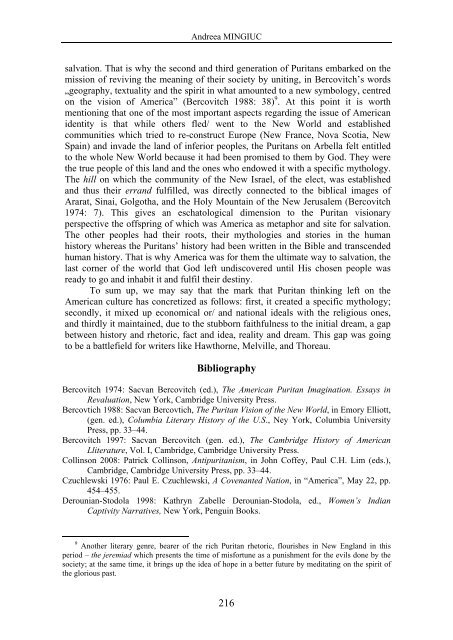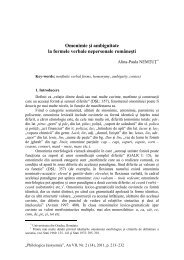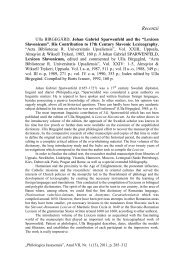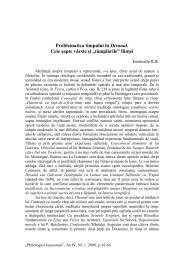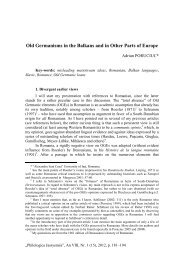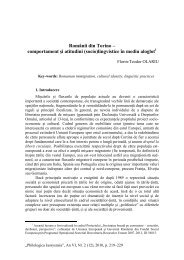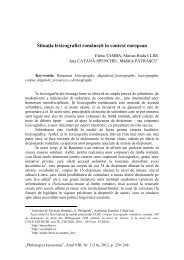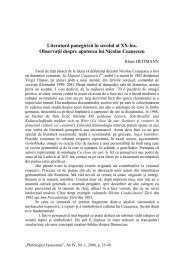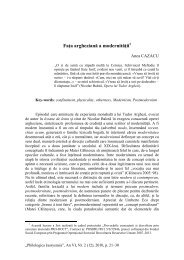Key Concepts of Puritanism and the Shaping of the American Cultural
Key Concepts of Puritanism and the Shaping of the American Cultural
Key Concepts of Puritanism and the Shaping of the American Cultural
Create successful ePaper yourself
Turn your PDF publications into a flip-book with our unique Google optimized e-Paper software.
Andreea MINGIUC<br />
salvation. That is why <strong>the</strong> second <strong>and</strong> third generation <strong>of</strong> Puritans embarked on <strong>the</strong><br />
mission <strong>of</strong> reviving <strong>the</strong> meaning <strong>of</strong> <strong>the</strong>ir society by uniting, in Bercovitch’s words<br />
„geography, textuality <strong>and</strong> <strong>the</strong> spirit in what amounted to a new symbology, centred<br />
on <strong>the</strong> vision <strong>of</strong> America” (Bercovitch 1988: 38) 9 . At this point it is worth<br />
mentioning that one <strong>of</strong> <strong>the</strong> most important aspects regarding <strong>the</strong> issue <strong>of</strong> <strong>American</strong><br />
identity is that while o<strong>the</strong>rs fled/ went to <strong>the</strong> New World <strong>and</strong> established<br />
communities which tried to re-construct Europe (New France, Nova Scotia, New<br />
Spain) <strong>and</strong> invade <strong>the</strong> l<strong>and</strong> <strong>of</strong> inferior peoples, <strong>the</strong> Puritans on Arbella felt entitled<br />
to <strong>the</strong> whole New World because it had been promised to <strong>the</strong>m by God. They were<br />
<strong>the</strong> true people <strong>of</strong> this l<strong>and</strong> <strong>and</strong> <strong>the</strong> ones who endowed it with a specific mythology.<br />
The hill on which <strong>the</strong> community <strong>of</strong> <strong>the</strong> New Israel, <strong>of</strong> <strong>the</strong> elect, was established<br />
<strong>and</strong> thus <strong>the</strong>ir err<strong>and</strong> fulfilled, was directly connected to <strong>the</strong> biblical images <strong>of</strong><br />
Ararat, Sinai, Golgotha, <strong>and</strong> <strong>the</strong> Holy Mountain <strong>of</strong> <strong>the</strong> New Jerusalem (Bercovitch<br />
1974: 7). This gives an eschatological dimension to <strong>the</strong> Puritan visionary<br />
perspective <strong>the</strong> <strong>of</strong>fspring <strong>of</strong> which was America as metaphor <strong>and</strong> site for salvation.<br />
The o<strong>the</strong>r peoples had <strong>the</strong>ir roots, <strong>the</strong>ir mythologies <strong>and</strong> stories in <strong>the</strong> human<br />
history whereas <strong>the</strong> Puritans’ history had been written in <strong>the</strong> Bible <strong>and</strong> transcended<br />
human history. That is why America was for <strong>the</strong>m <strong>the</strong> ultimate way to salvation, <strong>the</strong><br />
last corner <strong>of</strong> <strong>the</strong> world that God left undiscovered until His chosen people was<br />
ready to go <strong>and</strong> inhabit it <strong>and</strong> fulfil <strong>the</strong>ir destiny.<br />
To sum up, we may say that <strong>the</strong> mark that Puritan thinking left on <strong>the</strong><br />
<strong>American</strong> culture has concretized as follows: first, it created a specific mythology;<br />
secondly, it mixed up economical or/ <strong>and</strong> national ideals with <strong>the</strong> religious ones,<br />
<strong>and</strong> thirdly it maintained, due to <strong>the</strong> stubborn faithfulness to <strong>the</strong> initial dream, a gap<br />
between history <strong>and</strong> rhetoric, fact <strong>and</strong> idea, reality <strong>and</strong> dream. This gap was going<br />
to be a battlefield for writers like Hawthorne, Melville, <strong>and</strong> Thoreau.<br />
Bibliography<br />
Bercovitch 1974: Sacvan Bercovitch (ed.), The <strong>American</strong> Puritan Imagination. Essays in<br />
Revaluation, New York, Cambridge University Press.<br />
Bercovtich 1988: Sacvan Bercovtich, The Puritan Vision <strong>of</strong> <strong>the</strong> New World, in Emory Elliott,<br />
(gen. ed.), Columbia Literary History <strong>of</strong> <strong>the</strong> U.S., Ney York, Columbia University<br />
Press, pp. 33–44.<br />
Bercovitch 1997: Sacvan Bercovitch (gen. ed.), The Cambridge History <strong>of</strong> <strong>American</strong><br />
Lliterature, Vol. I, Cambridge, Cambridge University Press.<br />
Collinson 2008: Patrick Collinson, Antipuritanism, in John C<strong>of</strong>fey, Paul C.H. Lim (eds.),<br />
Cambridge, Cambridge University Press, pp. 33–44.<br />
Czuchlewski 1976: Paul E. Czuchlewski, A Covenanted Nation, in “America”, May 22, pp.<br />
454–455.<br />
Derounian-Stodola 1998: Kathryn Zabelle Derounian-Stodola, ed., Women’s Indian<br />
Captivity Narratives, New York, Penguin Books.<br />
9 Ano<strong>the</strong>r literary genre, bearer <strong>of</strong> <strong>the</strong> rich Puritan rhetoric, flourishes in New Engl<strong>and</strong> in this<br />
period – <strong>the</strong> jeremiad which presents <strong>the</strong> time <strong>of</strong> misfortune as a punishment for <strong>the</strong> evils done by <strong>the</strong><br />
society; at <strong>the</strong> same time, it brings up <strong>the</strong> idea <strong>of</strong> hope in a better future by meditating on <strong>the</strong> spirit <strong>of</strong><br />
<strong>the</strong> glorious past.<br />
216


